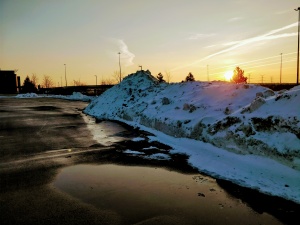Salt
LSRCA commissioned a study into salt management design strategies for parking lots. The entire report can be read here: LSRCA salt guide.
The report identified four key design strategies. They may be summarized as:
Effective Grading[edit]
- Areas for vehicular and pedestrian traffic should be graded between 2 - 4 % to reduce the chances of depressions forming over time (maximum permitted 5% for AODA). Small depressions can result in ponded water icing over in the winter.
- Sub bases should be well compacted for the same reason. Preventing ponding and ice formation reduces the salting requirements for those surfaces.
- In winter months efficient salt application should be made along the top of slopes; melting snow will carry the salt solution down-gradient.
Snow Piles[edit]
- Storage locations for snow piles should be in sunny areas with low traffic.
- Consider grading the storage location to distribute the melt-water as sheet flow over a grass filter strip into an adjacent BMP, such as a bioretention cell or infiltration trench. In some cases, with careful vegetation selection and adequate drainage, the BMP itself can serve as a snow storage location.
- Snow storage areas should be clearly marked for seasonal maintenance staff.
Sidewalk Design and Pedestrian Flow[edit]
- Sidewalks that receive infrequent use could be closed for the winter season.
- Maintained sidewalks should be ≥ 1.5 m wide to accommodate plowing and minimize the salting required.
- Using textured pavers can improve grip for pedestrians, again reducing the salt required.
- In busy areas around building entrances, covered walkways and heated mats also reduce salt requirements.
Trees[edit]
- Specifying deciduous trees will maximize winter sunlight penetration. This will naturally enhance the melting of frozen surfaces, limiting the need for winter maintenance.
Other vegetation[edit]
Vegetation varies in its reaction to soils with high salinity:
- Salt in soil water generally makes it more difficult for roots to take up water. This phenomenon mimics drought conditions for the plant.
- If passing traffic sprays salty water onto plants it can reduce cold hardiness in buds and new twigs. These then become more susceptible to freezing, mortality or deformation.
- In high enough concentrations, sodium and chloride can also be directly toxic to plants. In some species the ions are absorbed by the plant and build up in the leaves causing them to die.
Generally, the vegetation growing closest to the source will be most strongly affected by salt. Plants actively growing in late winter (when salt levels are highest) are also more significantly affected. So, warm season grasses offer an advantage over cool season grasses, because they emerge later in the spring when excess salt has been flushed away. Resilient turf grasses are particularly useful in the design of vegetated filter strips, dry ponds and enhanced grass swales. The Ministry of Transportation have standardized a number of grass mixes[1]. The 'Salt Tolerant Mix' is of particular value for low impact development applications alongside asphalt roadways and paved walkways.
| Common name | Scientific name | Proportion |
|---|---|---|
| Tall Fescue | Festuca arundinacea | 25 % |
| Fults Alkali Grass | Puccinellia distans | 20 % |
| Creeping Red Fescue | Festuca rubra | 25 % |
| Perennial ryegrass | Lolium perrenne | 20 % |
| Hard Fescue | Festuca trachyphylla | 10 % |
External links[edit]
- ↑ Ontario Provincial Standard Specification. (2014). Construction Specification and for Seed and Cover OPSS.PROV 804. Retrieved from http://www.raqsb.mto.gov.on.ca/techpubs/ops.nsf/0/3a785d2f480f9349852580820062910a/$FILE/OPSS.PROV 804 Nov2014.pdf
